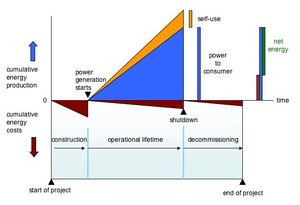Energy return on investment (EROI) for photovoltaic energy
| Topics: |
Contents
Introduction Figure 1. The distribution of solar radiation (Energy return on investment (EROI) for photovoltaic energy) at the earth's surface. (Source: NASA)
Approximately 2,895,000 exajoules (EJ) of solar radiation reaches Earth’s atmosphere yearly. When measured by satellite on the outer surface of Earth's atmosphere, this equates to about 1,366 watts per square meter. Thus, for the whole Earth, with a cross section of 127,400,000 km2, the power is 1.740×1017 W. This is an enormouse energy flow. In fact, the amount of solar energy intercepted by the Earth every minute is greater than the amount of fossil fuel the world uses every year. Another way to look at it is that on average, every square meter of the Earth’s surface intercepts 5.4 GJ of energy, approximately the same amount extracted from a barrel of oil, 200 kg of coal, or 140 m3 of natural gas.
The challenge of harnessing this energy lies in the cost of intercepting, collecting, transforming, and transporting solar radiation to points of end use in sufficient forms and quantities to meet specific energy end uses. This is a formidable challenge due to the spatially diffuse nature of solar radiation. The land area of the lower 48 contiguous United States intercepts 4.7×1019 Btu per year, equivalent to 500 times of the nation’s annual energy use. But that energy is spread over nearly 3 million square miles of land area, so that the energy absorbed per unit area is just 1.5×1013 Btu per square mile per year. Due to the tilt of the Earth on its access, there is enormous spatial distribution in solar radation (Figure 1).Some regions are well-suited to capture direct solar radiation, while others clearly are not.
According to the International Energy Agency (IEA), the global installed photovoltaic energy capacity was just under 2.6 gigawatt (GW) by the end of 2004. This refers to capacity in the nineteen nations that comprise the International Energy Agency-Photovoltaic Power Systems Programme (IEA-PVPS). This amount of installed capacity represents a small fraction of the 3, 800 GW of total global power capacity of all kinds. However, the rate of PV installation is growing very quickly, averaging nearly 30% per year in the recent past. The vast majority of this growth in capacity was installed in Germany, Japan and the USA.
One technique for evaluating energy systems is net energy analysis, which seeks to compare the amount of energy delivered to society by a technology to the total energy required to find, extract, process, deliver, and otherwise upgrade that energy to a socially useful form. Energy return on investment (EROI) is the ratio of energy delivered to energy costs. In the case of electricity generation, the EROI entails the comparison of the electricity generated to the amount of primary energy used in the manufacture, transport, construction, operation, decommissioning, and other stages of the facility's life cycle (Figure 2). Comparing cumulative energy requirements with the amount of electricity the technology produces over its lifetime yields a simple ratio for energy return on investment (EROI):
EROI = (cumulative electricity generated) / (cumulative primary energy required)
This article reviews 51 different PV systems from thirteen distinct analyses, ranging in publication date from 1995 to 2010. A significant number of the studies we analyzed are based on conceptual models of PV systems due to the lack of readily available data from of operational systems. This survey shows average EROI for all studies (operational and conceptual) of 6.56 (n=60 std. dev=4.69).
Methodological Issues
System Boundary
The choice about system boundaries is perhaps the most important decision made in most in net energy analyses. One of the most critical differences among the diverse studies is the number of stages in the life cycle of an energy system that are assessed and compared against the cumulative lifetime energy output of the system. These stages include the manufacture of components, transportation of components to the construction site, the construction of the facility itself, operation and maintenance over the lifetime of the facility, overhead, possible grid connection costs, and decommissioning. Energy systems have external costs as well, most notably environmental and human health costs, although these are difficult to assess in monetary and energy terms. No study as yet attempted to assess the environmental costs of photovoltaic energy in energy terms.
Methodology
Three types of net energy analysis techniques are used to calculate the net energy derived from wind power: process analysis, input-output analysis, and a hybrid analysis. The assumptions, strengths, and weaknesses of these approaches are discussed below.
Operating Characteristics
Many analyses must make important assumptions regarding the operating characteristics of PV energy systems. These include efficiency of solar energy conversion assumed lifetime, and capacity factors. Changes in the assumptions made about these factors, or deviations in actual operating conditions from assumed conditions can have a significant impact on results.
Conceptual versus Empirical Studies
Many studies use the theoretical or ideal operating characteristics of a PV system that are derived from simulated or assumed costs and operating conditions, e.g., a system of a given power rating, costing a certain dollar amount, in a location with an assumed rate of solar insolation with an assumed efficiency of conversion, and so on. Of course, actual operating conditions always deviate from assumed conditions. Empirical analyses rely on actual costs, operating conditions, and energy outputs, and thus provide a better metric of an energy system's contribution to a nation's energy supply. We distinguish between these two types of analyses of our discussion.

1 Comment
Keith Breinlinger wrote: 09-20-2010 18:59:31
Where is the rest of the article? You say: This article reviews 51 different PV systems from thirteen distinct analyses, ranging in publication date from 1995 to 2010...where is this detailed analysis? I believe EROI is very important and I think some of the "green" ideas that are put forward would fail a simple EROI analysis.